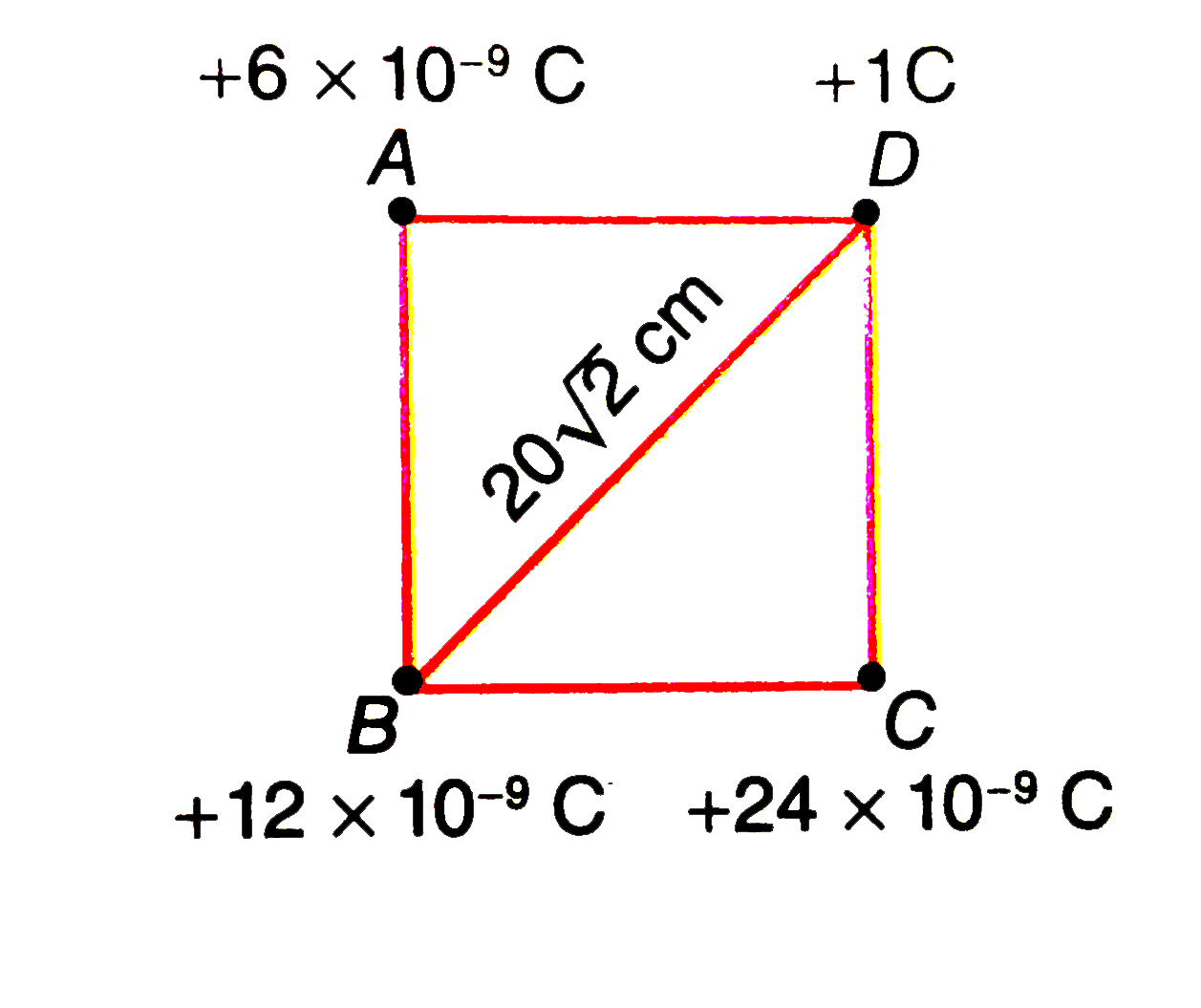Positive charges of magnitude 6nC, 12 nC, and 24 nC are placed at the vertices, A, B and C of a square ABCD of side 20 cm. What is the amount of work done to place a charge of 1C at vertex D?Solution in Bengali
The length of diagonal BD=√202+202=20√2cm
The electric potential at D,
VD=14πε0[qAAD+qCCD+qBBD]
14πε0[6×10−920×10−2+24×10−920×10−2+12×10−920√2×10−2]
9×109×10−910−2[620+2420+12√240]
=900[12+48+12×1.41440]=452×76.968
=1731.78V

Hence the work done to place a charge of 1C at D = 1731.78 J.
Topper's Solved these Questions
- ELECTRIC POTENTIAL BOOK - CHHAYA PUBLICATIONCHAPTER - ELECTRIC POTENTIAL EXERCISE - Section related questions
25 Videos
- ELECTRIC POTENTIAL BOOK - CHHAYA PUBLICATIONCHAPTER - ELECTRIC POTENTIAL EXERCISE - Higher order thinking skill (HOTS) questions
23 Videos
- ELECTRIC FIELDBOOK - CHHAYA PUBLICATIONCHAPTER - ELECTRIC FIELDEXERCISE - CBSE SCANNER
31 Videos
- ELECTROMAGNETIC INDUCTION & ALTERNATING CURRENTBOOK - CHHAYA PUBLICATIONCHAPTER - ELECTROMAGNETIC INDUCTION & ALTERNATING CURRENTEXERCISE - CBSE SCANNER
28 Videos
Similar Questions
What do you mean by potential of a charged body?
View SolutionIf the intensity at a point in an electric field is zero, will the electric potential be also zero at that point? If the electric potential be zero at a point, will the intensity be also zero at the point?
View SolutionA charge q is placed at the centre of a cube of side l. What is the electric flux passing through each face of the cube?
View SolutionA bar magnet is moved in the direction indicated by the arrow between two coils PQ and CD. Predict the directions of induced current in each coil.

View SolutionA point charge q1=4.00nC is placed at the origin, and a second point charge q2=−3.00nC, placed on the x-axis at x = + 20.0 cm. A third point charge q3=2.00nC is placed on the X-axis between q1,andq2. (Take as zero the potential energy of the three charges when they are infinitely far apart).
(a) What is the potential energy of the system of the three charges if q3 is placed at x= + 10.0 cm?
(b) Where should q3 be placed to make the potential energy of the system equal to zero?
View SolutionA charge of 5 mu C is placed at the center of a square ABCD of side 10 cm . Find the work done ("in" mu J) in moving a charge of 1 mu C from A to B.
View SolutionA charge of 60n C (nanocouloumb) is palced at the corner A of a square ABCD is side 10cm. Another charge of -10nc is located at the centre of the square. Find the work done in carrying a charge of +5 nC from the corner C to the corner B of square.
View SolutionPositive charges of 6,12 and 24 nC are placed at the thre vertices of a square. What charge must be placed at fourth vertex so that total potential at the centre of the square is zero?
View SolutionIn the given figure, there are four point charges placed at the vertices of a square of side, a=1.4 m . If q_(1)=+18 nC,q_(2)=-24 nC,q_(3)+35nC and q_(4)=+16 nC m then find the electric at the centre P of the square Assume the potential to be zero at infinity.
View SolutionThree point charges 3 nC , 6 nC and 9 nC are placed at the corners of an equilateral triangle of side 0.1 m . The potential energy of the system is
View SolutionTwo point charges A = +3 nC and B = +1 nC are placed 5 cm apart in air. The work done to move charge B towards A by 1 cm is
View SolutionTwo identical charges of magnitude 0.4 mC are placed on diagonally opposite vertices of a square of side 10 cm. Calculate the amount of work done in slowly moving one of the charges from diagonally opposite vertex to adjacent vertex.
View SolutionA charge of 0.5 nC is placed at the centre of an equilateral triangle of side 10 cm. Calculate the potential at all the three vertices of the triangle.
View SolutionA charge of 0.5 nC is placed at the centre of an equilateral triangle of side 10 cm, calculate the work done in bringing a charge of 0.1 nC from infinity to any vertices of the triangle.
View SolutionWhat is the electric potential at point P, located at the center of the square of charged particles shown in Fig. 24-16a? The distanced is 1.3 m, and the charges are
q1=+12nC, q3=+31nC,
q2=−24nC, q4=+17nC.
View Solution
